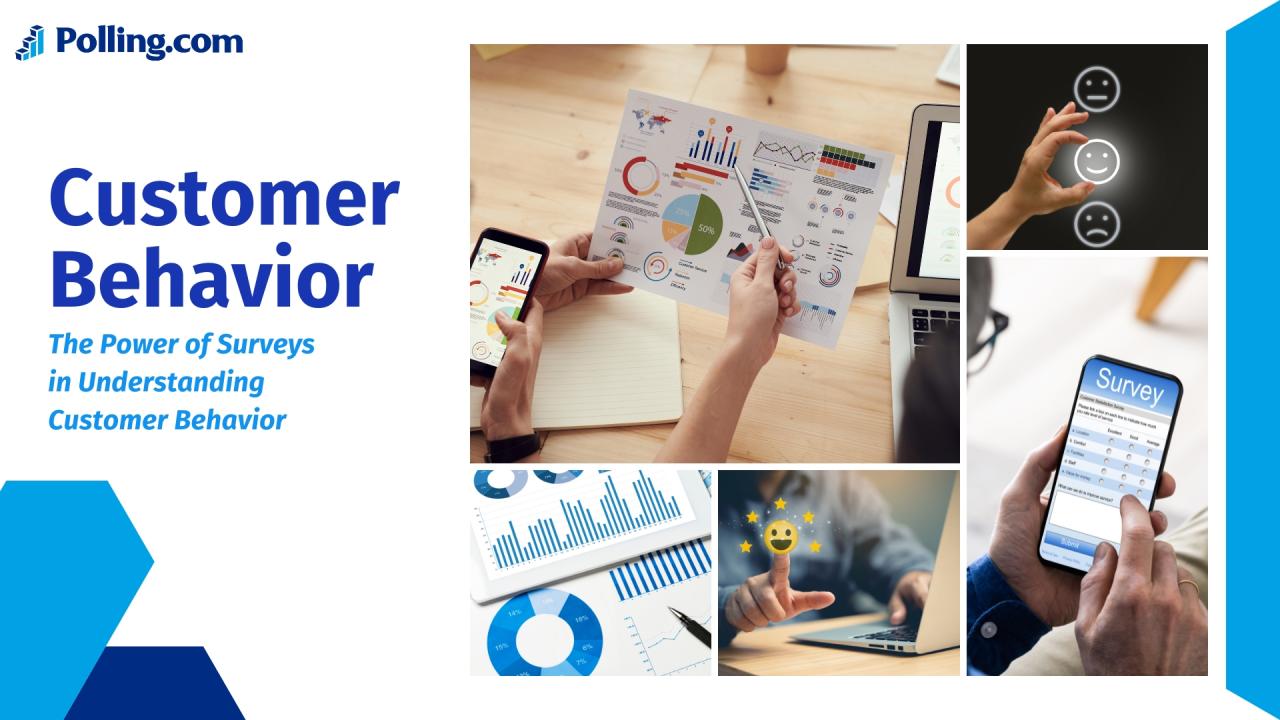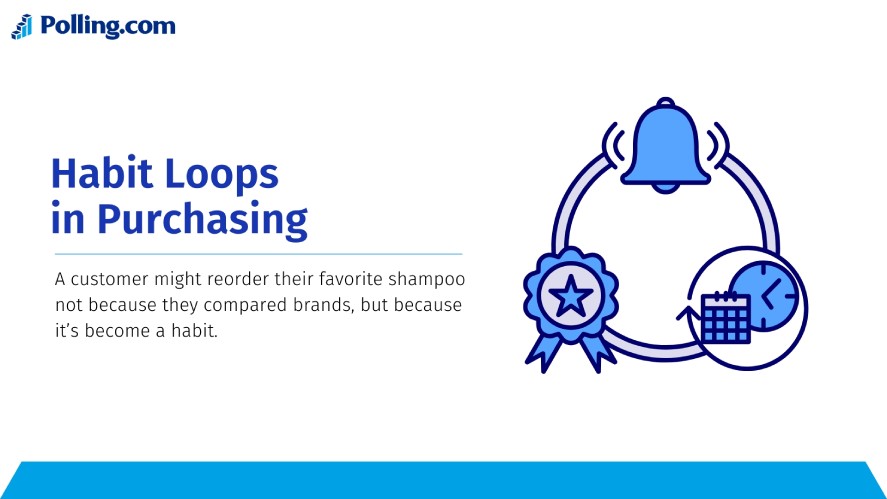
Understanding Customer Behavior: Best Practices and Survey Tips
Want to boost your business growth? Understanding customer behavior is your ticket to crafting marketing campaigns, products, and experiences that hit the mark.
Surveys for customers give you a direct line to what makes your audience tick, revealing why they buy or bounce. Picture a customer ditching your cart because the checkout feels clunky; survey questions for customers can pinpoint that pain.
Polling.com’s survey tools make customer behavior analysis a snap, turning customer feedback tools into data-driven wins.
In this article, let’s learn about understanding customer behavior through smart survey questions, how to analyze customer behavior effectively, and best practices for customer satisfaction surveys that lead to real improvements.
What Is Customer Behavior and Why Does It Matter?
Customer behavior is the sum of how people think, feel, and act when they engage with your brand, whether they’re buying your product, browsing your site, or skipping your ad.
It’s shaped by:
- Psychological factors like motivation, perception, or learning
- Personal traits such as age, income, or lifestyle
- Social influences like peer recommendations or online reviews
Understanding these factors is crucial. It helps businesses:
- Retain loyal customers by meeting expectations
- Attract new audiences by solving real problems
- Build long-term loyalty by aligning with customer values
For example, a gym uses survey responses to learn members prefer 30-minute classes over an hour. They adjust the schedule and increase subscription renewals by 15%. That’s customer behavior analysis in action.
Consumer Psychology: The Thinking Behind Customer Decisions
Understanding customer behavior isn’t just about tracking actions; it’s about uncovering why those actions happen.
At the heart of every purchase or interaction lies a complex mix of emotional and rational thinking.
Emotional vs. Rational Decisions
Customers rarely act on logic alone. Emotions like trust, excitement, fear, or urgency heavily influence the customer decision-making process.
For instance, a limited-time offer creates urgency, pushing users toward quicker decisions, even if they’re not ready.
Habit Loops in Purchasing
Many buying decisions become automatic over time. A customer might reorder their favorite shampoo not because they compared brands, but because it’s become a habit.

These loops form when a cue (e.g., running out) triggers a routine (buy again) and ends in a reward (clean hair, satisfaction).
The Power of Trust and Familiarity
Trust is another key emotional driver.
Brands that are transparent, consistent, and easy to use tend to win repeat behavior, even if competitors offer slightly better features or prices.
Understanding these buying behavior patterns helps you craft better survey questions and interpret feedback through a psychological lens.
The Role of Surveys in Understanding Customer Behavior
Surveys act like a two-way conversation with your audience, offering real-time feedback straight from the source.
They go beyond what click data can tell you, letting you ask why someone made a decision, not just what they did.
This makes surveys powerful for uncovering:
- Pain points (slow shipping, poor UX)
- Preferences (product features, pricing)
- Motivations (what made them choose you)
For instance, a customer satisfaction survey shows 70% of 200 respondents want faster delivery. That one stat could help you rework logistics and improve your competitive edge.
Tools like Polling.com make it simple to create, distribute, and analyze surveys, so you’re not just collecting data, you’re turning it into decisions that drive results.
Survey Strategies for Understanding Customer Behavior
You can get the scoop on understanding customer behavior by using targeted surveys for customers that reveal who your customers are, what they do, and why.
Here are key survey strategies to help you decode behavior.
- Demographic Surveys: Learn who your customers are (age, income, or location) to tailor your business growth efforts. For example, survey questions like “What’s your age range?” show if your app skews millennial, shaping ad campaigns.
- Behavioral Feedback Surveys: Discover what actions customers take and why, using questions to ask for surveys like “What stopped you from buying?”. This fuels customer behavior analysis to fix checkout hiccups.
- Customer Journey Surveys: Conduct user journey analysis to map behavior across touchpoints, from ads to purchase, with survey questions for customers like “How did you hear about us?” to reveal weak spots for NPS and improvements.
- NPS and CSAT Surveys: Assess satisfaction and brand perception with customer satisfaction surveys like “How likely are you to recommend us?”. High CSAT scores signal loyalty, guiding growth.
- Post-Purchase Surveys: Learn what tipped the scales and uncover purchase motivations with survey questions like “What convinced you to buy?”. This uncovers purchase drivers for marketing tweaks.
- Churn Surveys: Understand why customers leave with surveys for customers like “What made you cancel?”. This helps retention by fixing pain points
📌 Tip: Use pre-built templates from Polling.com to fast-track your survey creation and uncover trends quickly.
How to Analyze Survey Results for Deeper Behavioral Insights
Once you’ve collected responses, the real value comes from interpreting them effectively. Behavioral insights don’t just appear; they need to be discovered through thoughtful analysis.

Here’s a step-by-step guide to turn raw data into smart, actionable decisions.
1. Segment Your Responses for Deeper Comparisons
Don’t just look at averages, instead, slice your data by meaningful segments. Break down responses by user type (new vs. returning), device (mobile vs. desktop), or lifecycle stage (trial vs. paid user).
For example:
- New users might struggle with onboarding, while long-time users request advanced features.
- Mobile users could report navigation issues not seen by desktop users.
Segment analysis helps you spot unique behavior patterns and see how different groups experience your product. This way, you can tailor improvements to fit their needs.
2. Identify Patterns and Repeated Themes
Look for recurring phrases, complaints, or suggestions in both quantitative and open-ended responses.
Are many users saying a feature is confusing? Do drop-off points cluster around a specific part of the user journey?
Common behavior flags include:
- Consistent mentions of pricing issues
- Users citing slow load times or confusing setup
- Frequent confusion around a particular feature
Recognizing these patterns helps pinpoint friction in the customer experience and reveals user intent signals that drive decisions.
3. Turn Insights into Actionable Improvements
Insights are only valuable if you act on them. So, use what you’ve learned to refine your product, messaging, or customer journey.
If users love a specific feature, highlight it more in ads or onboarding emails. Then, simplify areas that users find confusing, whether it’s a menu structure or a form layout.
Lastly, prioritize feature requests or bug fixes that come up repeatedly.
With tools like Polling.com, you can automate this loop, from collecting feedback to tagging responses and triggering alerts when sentiment shifts, making customer behavior insights part of your daily workflow.
Tools to Help Understand Customer Behavior Through Surveys
Picking the right survey tools is key to understanding customer behavior and driving business growth.
Customer feedback tools like the ones below help you craft surveys for customers to uncover actionable insights, but each has its strengths and limits.
- Polling.com: Offers customizable surveys with real-time analytics, perfect for business growth strategies. Its user-friendly interface and scalable design suit startups to enterprises, letting you analyze survey questions for customers fast. Ideal for businesses wanting quick, powerful insights without complexity.
- Google Forms: A free option with basic survey questions but limited analytics. Great for small-scale customer satisfaction surveys, but lacks depth for robust customer behavior analysis.
- Typeform: Boasts a sleek UI and engaging survey questions for customers, but its analytics fall short for data-heavy customer behavior studies. Best for visually appealing, simple surveys.
- Qualtrics: An enterprise-level tool with advanced behavioral analytics for customer behavior analysis, but its complexity can overwhelm non-experts. Suits large firms with big budgets.
So, why choosing Polling.com? Its fast, powerful, and user-friendly survey tools let you create tailored surveys for customers, analyze customer feedback instantly, and scale effortlessly.
Mistakes to Avoid When Surveying for Behavioral Insights
To truly understand customer behavior, it’s not just about asking questions; it’s about asking the right questions, to the right people, at the right time.
Avoiding these common survey missteps will help you gather meaningful, actionable insights that drive real business growth.

Asking the Wrong Types of Questions
The biggest mistake in behavioral surveys is using poorly framed questions. Ambiguous or leading questions confuse respondents, while irrelevant ones yield noise instead of insights.
For example, instead of asking, “Do you like our brand?”, which is vague, ask “What was the main reason you chose our product over competitors?”. This gives you specific behavioral insight tied to a decision-making process.
Ignoring Customer Segmentation
Analyzing survey results as a single lump group overlooks critical patterns. New users behave differently than loyal ones, and teens shop differently than retirees.
If you don’t break down data by demographic, behavioral, or lifecycle segments, you risk making generalized decisions that fail to address key audiences.
Over-Surveying Your Audience
Too many surveys too often equal annoyed users and lower response rates. Fatigued customers are more likely to skip your surveys or provide low-effort responses, weakening your data quality.
So, only survey at key customer journey moments, keep it short (5 questions or less), and offer small incentives if needed.
Not Acting on Collected Data
Collecting survey data is only the first step. Too many businesses gather valuable feedback and then do nothing.
This damages customer trust and wastes time and effort. To fix it, share findings across your team, set up a feedback-to-action workflow, and show your audience you’re listening.
Conclusion
Surveys for customers are your shortcut to understanding customer behavior, revealing what makes your audience click, stay, or stray.
From survey questions that map journeys to customer behavior analysis, the right survey tools turn customer feedback into business growth strategies.
Intuitive platforms like Polling.com simplify crafting customer satisfaction surveys and analyzing insights, no expertise needed. Start building surveys today with Polling.com to unlock actionable insights that fuel your business growth.
